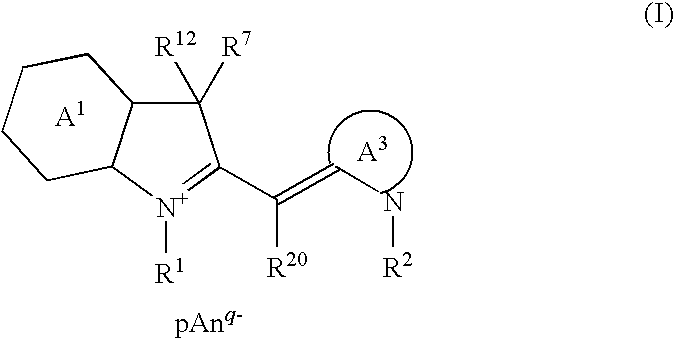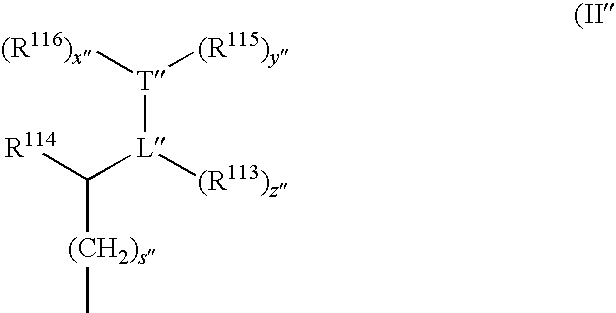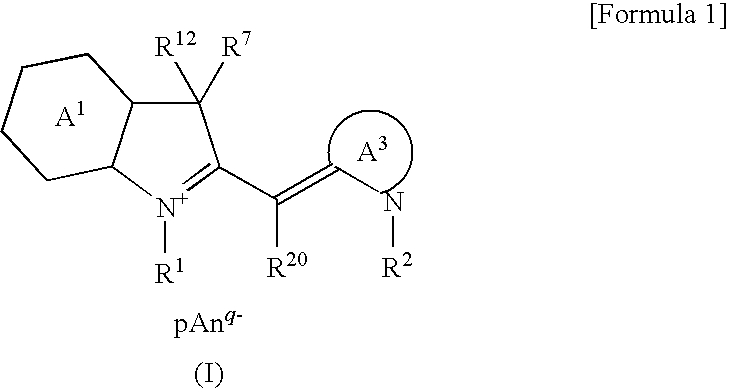Cyanine compound and optical recording material
a technology which is applied in the field of cyanine compound and optical recording material, can solve the problems of poor recording characteristics and absorption wavelength characteristics of cyanine compound
- Summary
- Abstract
- Description
- Claims
- Application Information
AI Technical Summary
Benefits of technology
Problems solved by technology
Method used
Image
Examples
examples
[0074]Hereafter, the present invention will be described in more detail in terms of Manufacturing Examples and Examples. However, the present invention will not be limited in any way by the following Examples and the like.
[0075]The following Manufacturing Examples 1 to 12 show examples of manufacture of the cyanine compounds of the present invention. Further, the following Examples 1 to 12 show examples of optical recording material and optical recording medium of the present invention using the cyanine compound of the present invention obtained in Manufacturing Examples 1 to 12. Comparative Example 1 shows an example of an optical recording material and an optical recording medium, which was prepared using a cyanine compound of a structure different from the cyanine compound of the present invention. Also, in the following Evaluation Example 1, thermal decomposition behavior was evaluated by measuring the melting and decomposition points of the cyanine compound of the present inven...
manufacturing example 4
Manufacture of a Quencher Anion (C) Salt of Cyanine Compound No. 2
[0082]To a reaction vessel were charged 0.69 mmol of tetrafluoroborate salt of cyanine compound No. 2, 0.69 mmol of a triethylamine salt of the anion represented by the chemical formula [C], and 3.6 g of pyridine, and the mixture was stirred at 60° C. for 2 hrs. and, after addition of 8 g of methanol, was allowed to cool to room temperature. The precipitated solid was collected by filtration and dried under vacuum to obtain the desired quencher anion (C) salt of compound No. 2. The compound obtained was identified by IR and 1H-NMR analyses. The analytical results are shown in [Table 2] and [Table 3]. Also, in [Table 1], the yield of the compound synthesized and results of measurement of the characteristic values [optical absorption characteristics (λmax and ε at λmax) dissolved in a solution] are shown.
manufacturing examples 6 and 7
Manufacture of Quencher Anion (D) Salts of Cyanine Compound Nos. 35 and No. 36
[0083]Except that triethylamine salt of an anion represented by the chemical formula (D) was used instead of the triethylamine salt of anion represented by the chemical formula (C), the reaction was carried out in a similar manner as in Manufacturing Example 4 to obtain the respective, desired quencher anion (D) salts of compound Nos. 35 and 36. The compounds obtained were identified by IR and 1H-NMR analyses. The analytical data are shown in [Table 2] and [Table 3]. Also, in [Table 1], yields of the compounds synthesized and results of measurement of the characteristic values [optical absorption characteristics (λmax and ε at λmax) in solution state] are shown.
[0084]
TABLE 1YieldεCyanine compound(%)λmax(×104)ManufacturingTetrafluoroborate salt36460.04.37Example 1of compound No. 1ManufacturingTetrafluoroborate salt8.3475.53.86Example 2of compound No. 2ManufacturingTetrafluoroborate salt60457.54.74Example 3o...
PUM
| Property | Measurement | Unit |
|---|---|---|
| wavelength | aaaaa | aaaaa |
| wavelength | aaaaa | aaaaa |
| wavelength | aaaaa | aaaaa |
Abstract
Description
Claims
Application Information
 Login to View More
Login to View More - R&D
- Intellectual Property
- Life Sciences
- Materials
- Tech Scout
- Unparalleled Data Quality
- Higher Quality Content
- 60% Fewer Hallucinations
Browse by: Latest US Patents, China's latest patents, Technical Efficacy Thesaurus, Application Domain, Technology Topic, Popular Technical Reports.
© 2025 PatSnap. All rights reserved.Legal|Privacy policy|Modern Slavery Act Transparency Statement|Sitemap|About US| Contact US: help@patsnap.com



